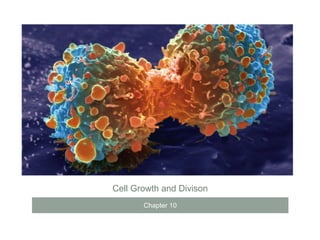
Chapter 10 notes - Cell Growth and Division
- 1. Cell Growth and Divison Chapter 10
- 2. 10.1 Cell growth, division, and reproduction Limits to Cell Size We learned in Chapter 7, that small cells are more efficient than large cells. •The larger a cell becomes, • the more demands the cell places on its DNA • the less efficient in moving nutrients and waste materials across the cell membrane.
- 3. Cells need a high sa/v ratio
- 4. Cell Division An adult produces 25 million new cells per second. Why do cells divide? 1. 2. 3. Asexual reproduction Unicellular organism developing into a multicellular organism (growth) Renewal and Repair of damaged cells • In each situation DNA must be present in each new cell. • When a cell divides the DNA is copied and distributed so that each cell ends up with an exact copy of the DNA.
- 5. Asexual Reproduction • Prokaryotic cells reproduce by binary fission • Produces identical offspring where a parent passes exact copies of its DNA to its offspring. parent cell DNA duplicates cell begins to divide daughter cells
- 6. Asexual reproduction Eukaryotic organisms can also reproduce asexually. • Budding forms a new organism from a small projection growing on the surface of the parent. • Fragmentation is the splitting of the parent into pieces that each grow into a new organism. Hydra bud Yeast
- 7. Sexual reproduction • Involves the fusion of two parent cells • Offspring inherit some information from each parent
- 8. 10.2 THE PROCESS OF CELL DIVISION CHROMOSOMES – condensed chromatin •A single molecule of DNA has thousands of genes •DNA is arranged into chromosomes • Prokaryotes – single circular chromosome in cytoplasm • Eukaryotes – multiple chromosomes are located in the nucleus
- 9. Eukaryotic Chromosomes • Each chromosome is made up of 2 sister chromatids • The sister chromatids are attached at a centromere chromatid centromere Condensed, duplicated chromosome
- 10. Chromosomes in Sexual Reproduction • Somatic Cell – normal body cell, not a sperm or egg cell. • Diploid • In a normal human contains 46 chromosomes • Gamete – sex cell, sperm or egg • Haploid • In a normal human contains 23 chromosomes • Why? • When two haploid gametes fuse in fertilization, the result is a diploid zygote (the first cell of a new individual).
- 11. The Cell Cycle The cell cycle is a regular pattern of growth, DNA replication, and cell division.
- 12. Stages of the Cell Cycle • Interphase • G1: cell growth and normal functions • S (synthesis): copies DNA • G2: additional growth and preparation for division • Cell Division (M phase) • Mitosis • division of the cell nucleus • Cytokinesis • division of the cell cytoplasm
- 13. interphase Before cell division can begin the cell will go through interphase. Parent cell in Interphase centrioles spindle fibers centrosome nucleus with DNA
- 14. Steps of Mitosis • Step I: Prophase • chromosomes condense • Spindle fibers form from centrioles. • Nucleolus disappears and the nuclear envelope breaks down
- 15. • Step 2: Metaphase • Centromeres of chromosomes line up in the middle of the cell • Spindles attach to centromeres
- 16. • Step 3: Anaphase • sister chromatids separate and move along the spindle fibers to opposite sides of the cell
- 17. • Step 4: Telophase the new nuclear envelopes form and chromosomes begin to uncoil into chromatin Mitosis is complete! (cell division still has one more step)
- 18. Cytokinesis • In animal cells, the membrane pinches closed.
- 19. • In plant cells, a cell plate forms. • After cytokinesis in all cells, each new cell begins interphase. • Cells Alive Animation
- 21. Review Questions Compare asexual and sexual reproduction. How does cytokinesis compare in plant and animal cells? Describe the relationship between the following terms: chromatin, chromosomes, chromatid, and centromere. Mitosis song
- 22. 10.3 regulating the Cell Cycle • One of the most important internal factors that regulate the cell cycle are: • Cyclins (regulatory proteins)
- 23. External Factor • Normal cells stop dividing when they touch each other.
- 24. Cancer cells • If one of these factors is mutated regulation of growth and division can be disrupted. • Cancer cells do not respond normally to the bodys control mechanisms. • As a result they divide uncontrollably and form a mass of cells called a tumor. Metastasis Animation
- 25. 10.4 Cell Differentiation • As a zygote grows into stem cells, and then an embryo, the cells become specialized through the process of differentiation. • Differentiated cells are specialized to perform certain jobs. • Example: nerve cells, muscle cell, blood cell, skin cell
- 26. Stem Cell Research • Embryonic stem cells vs. adult stem cells • Benefits • Fix damaged cells • Treat devastating diseases (leukemia, diabetes) • Issues • Ethics • Expensive